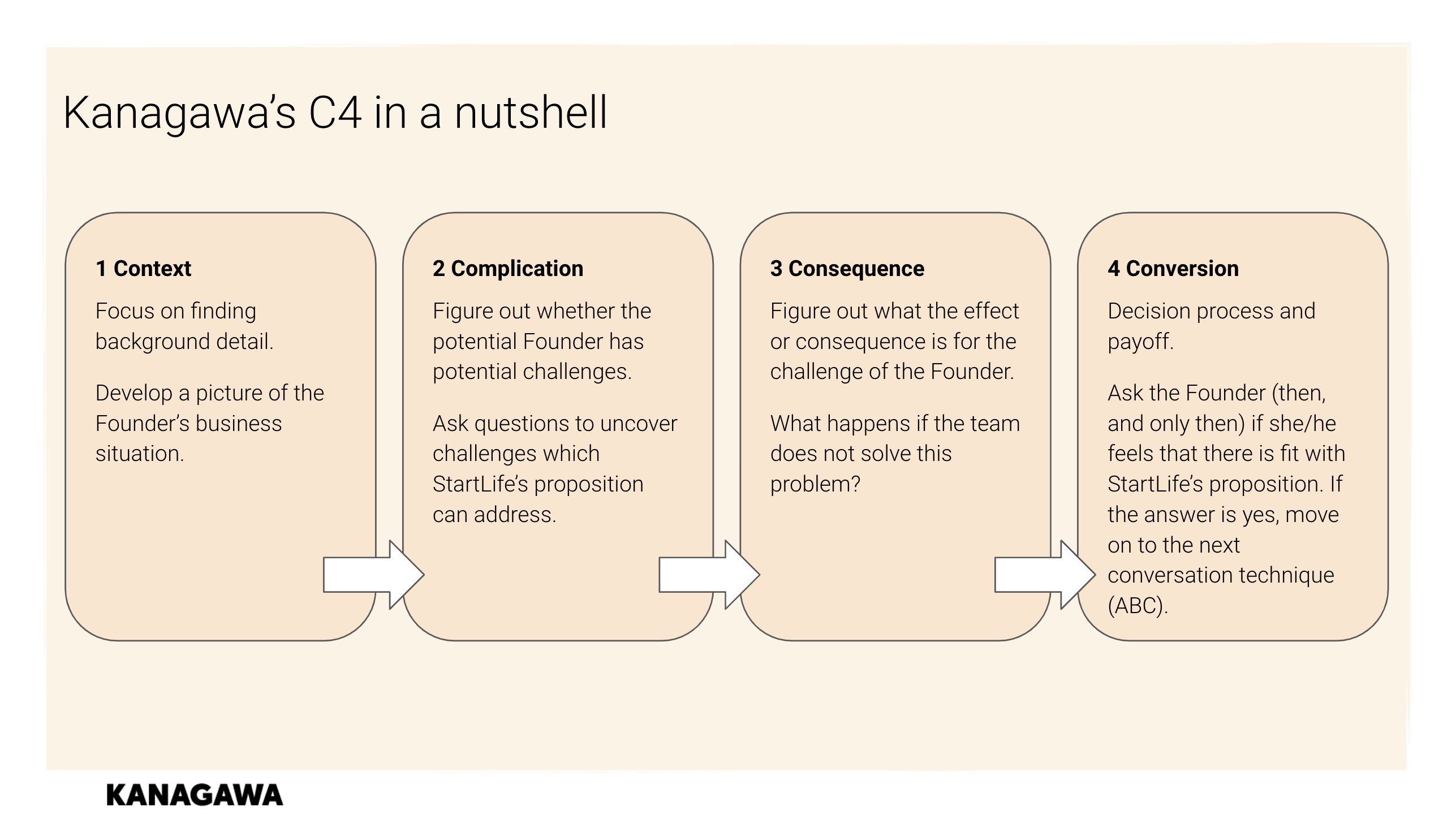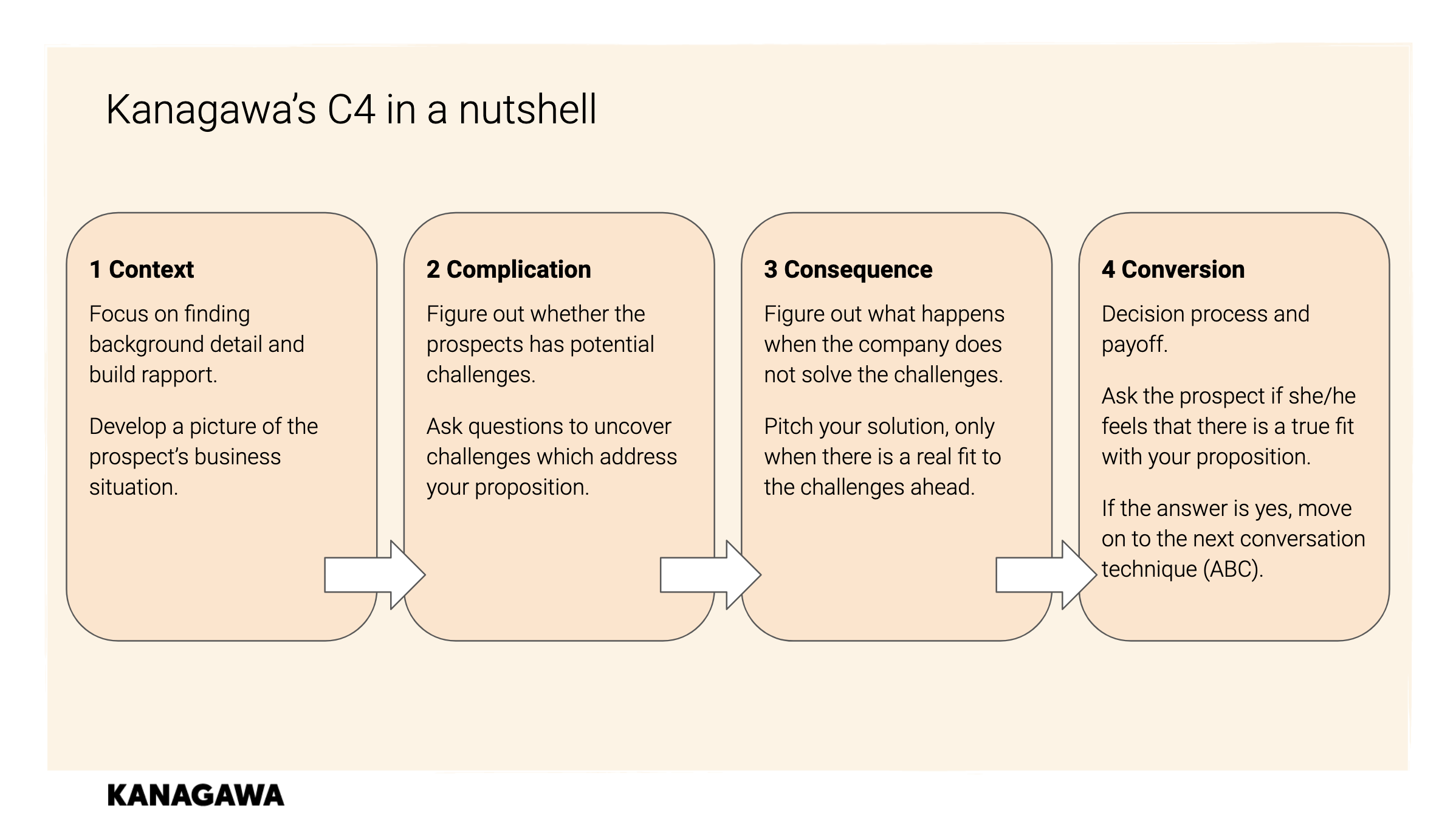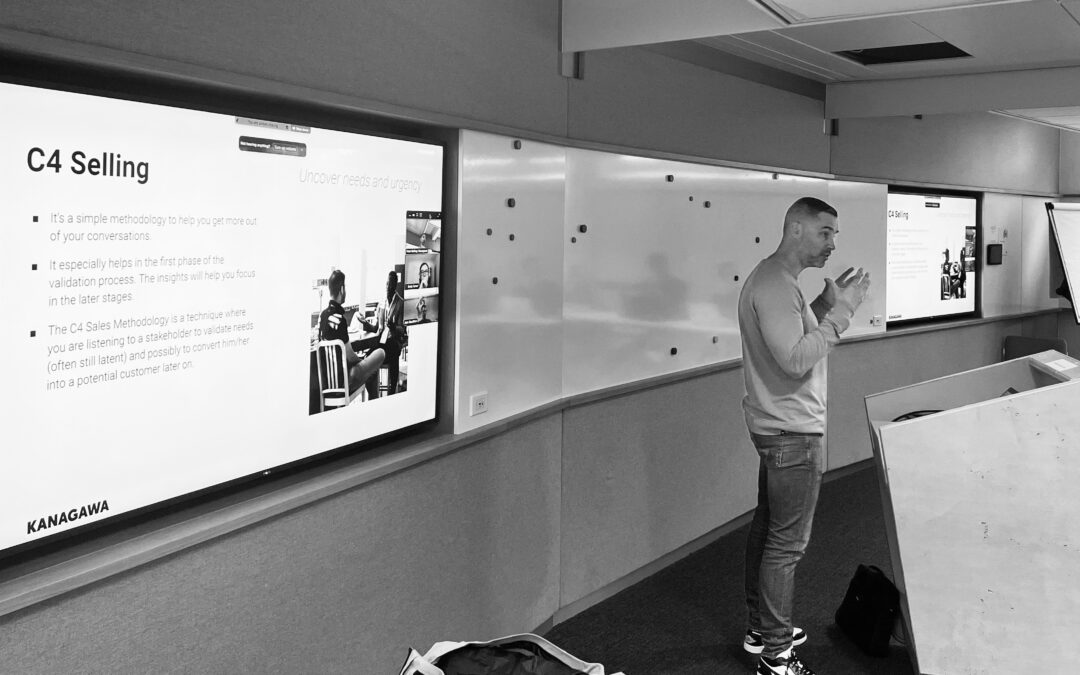Learn about our tried and tested sales methodology.
Ask any sales manager, and they will tell you that sales are chaotic. That’s because all customers are different, their needs are different, and their behavior is unpredictable.
To navigate this highly volatile field, sales reps need structure and consistency to keep things as orderly as possible.
That’s why every sales team has definite sales processes tied to an effective sales methodology.
While there are several sales methodologies widely accessible and applicable, in our 20 years of sales optimization experience across various industries and types of customers, we have found that the most effective sales methodology is the C4 Sales Methodology.
This sales methodology is simple to learn, implement, track, and scale and helps you to create a sustainable sales approach. In this post, we will dive into the four Cs and what they mean. There are also sample questions to help you implement them in your sales function.
What are the 4 C’s of Sales?
The C4 Sales Methodology addresses how a conversation should be structured between a sales rep and a potential customer.
Remember, before initiating every conversation, it’s important to obtain the correct information to identify the problem, the urgency, and the factors that decide a purchase.
The C4 Sales Methodology has been divided into four axes. Let’s look at each one of them:


1. Context
Context is one of the most important axes in the C4 Sales Methodology. It aims to understand the different external factors, like social, cultural, political, technological, trends, etc., influencing the customer’s buying decision.
This stage helps to find the background details of the customer to understand the buyer’s business situation better.
During this stage, the focus is more on understanding the customer, their business challenges, and how they currently manage the problem.
In this stage, the sales rep asks probing questions like key metrics and KPI’s that matter most to the customer to understand better what the customer values most.
Questions to ask for Context:
- Could you please explain your role within [COMPANY] in more detail? What are your main responsibilities? The same goes for your department. Please name 3.
- How do you measure the success of your work? Which KPIs are most important to you/your department?
- What are the most important challenges regarding [industry in which the customer is active]?
- How do you deal with [product/service customers]?
- How do you decide about how [product/service customer]?
- Have experiments been done, and what has been learned?
- [Insight into customer situation]. Why is that? Do you have experience with this?
2. Complication
Now that you understand the customer and their business, it’s time to investigate their pain points.
This is the most crucial stage as this will help you to understand the customer’s problem deeply.Remember, you won’t be able to devise a solution for the customer until you understand their problem well. So, carefully select your questions to gain maximum insights. Here are some sample questions that can help you get started.
Questions to ask for the Complication axis:
- What are the biggest bottlenecks regarding [product/service customer]?
- What do you think of the current [customer most important KPI] of your [product/service customer]?
- What do your customers think of the [situation specific] experience [product/service customer]?
- How do you measure that?
- What would you like to see differently regarding [product/service customer]?
- …[complete per situation]
3. Consequence
The next important axis in the C4 Sales Methodology is the consequence stage. This is an important stage that helps you understand how critical the issue is for the customer.
This also gives you a sense of urgency the customer may have to solve this problem. For example, a critical issue must be solved immediately, while a not-so-critical issue might not be on the customer’s priority list.
To gauge the consequences of the customer’s potential problems, ask meaningful questions like how their business will be impacted if the problem is unsolved. Or if they can still conduct business as usual without resolving the problem to understand what happens if the customer does not solve this problem.
Questions to ask for Consequence
- If these issues are not addressed now, what will be the impact (both for [COMPANY] and yourself)?
- Can you solve your top 3 challenges if such problems are not solved/changes are realized (link to situation)?
- …[complete per situation]
4. Conversion
The last and final axis in the C4 Sales Methodology is the Conversion axis. In this stage, your focus should be on converting the customer based on the information you received in the previous phases.
You should also focus on the purchasing process and make it as seamless as possible for the customer.
Ask questions based on the customer’s previous purchasing decisions to understand how the customer feels motivated to purchase, how they decide, and how they become convinced.
Here are some useful sample questions to help you get started:
- “When….?” “How did you know it was time?” (This identifies how the customer gets motivated to purchase based on their values.)
- How did you decide this was the (______) for you? (This sheds light on how the customer decides.)
- How can you be convinced that someone is competent in what he or she does? Was this the product/service you were looking for? (This helps identify how the customer feels convinced.
Some follow-up questions could be:
- Are you automatically convinced?
- Do they have to demonstrate their competence a number of times? How often?
- Do they have to demonstrate their competence over a certain period? How long?
- Or are you never convinced?
- How did you know you made a good decision? (This identifies how the customer feels assured that they have made the way someone is assured is the right choice.)
Questions to further deepen the selection process:
- Who else within [COMPANY] would benefit from such a solution?
- Who would be involved in choosing a solution and actually getting it approved and implemented?
- When would you ideally like to solve the previously discussed problems? When would you like to realize such changes/improvements (ideally as soon as possible)?
The final conversion question:
- Suppose we can help you provide an improved [customer experience regarding product/service that customer provides] with [XXX] impact on key KPIs. Would you like to try out such a solution with us (e.g., pilot)?
- Would this be a priority, or is there interest in initiating this within 4-8 weeks?
- …[complete per situation]
Remember, these questions are all suggestive; you don’t need to include them all. Doing so will only make the conversation look scripted and unnecessarily long. We suggest selecting a maximum of three questions per axis and adjusting during the conversation.
Not sure where to begin and get started with the C4 Sales Methodology? Let’s talk!
But before you walk away, let’s also quickly look into some of the ineffective sales tactics you must retire now.
Ineffective sales tactics to avoid
Now that we know the C4 Sales Methodology and understand how to implement it, let’s see which ineffective sales tactics you should avoid and why.
1. Depending too much on case studies
Relying too much on case studies is an ineffective sales tactic that sales reps should avoid, especially during the initial conversation period with the customer. Case studies are good resources to prove how you have solved a problem in the past, but they are not useful in handling objections at the beginning of the process.
2. Holding on to old positioning statement
Avoid holding on to old positioning statements; instead, focus on the customer/s pain points, how they are dealing with them, and what you can do to solve their problem.
3. Relying on heavy discounts
Some brands tend to lean too much on heavy discounts to grab the attention of the customer. Know that this is the least effective sales strategy because your potential customers might not be looking for a great ‘deal’ but a great ‘solution’ that solves their problem.
4. Avoid cold calling
The effectiveness of cold calling is dwindling, and sales reps should consider avoiding them if they can. Instead, a strategy of warm calling might be more effective. This includes calling targeted customers who can benefit from your product, researching and gathering information about them, and using video during outreach.
5. Keep it simple
Sales reps should keep things simple and double down on what works best for them rather than reinventing the sales wheel. Remember, the most successful sales teams worldwide stick to the simple sales methodology that is easy to learn, implement, track, and scale.
Key takeaway
Sales are complicated, and a solid sales methodology supports the sales reps to fall back upon. While there are plenty of sales methodologies to explore, we have figured out that the most simple and effective sales methodology is the C4 Sales Methodology.
Want to learn more about it and implement it within your sales team?
Allow us to help you! Schedule a call now.




